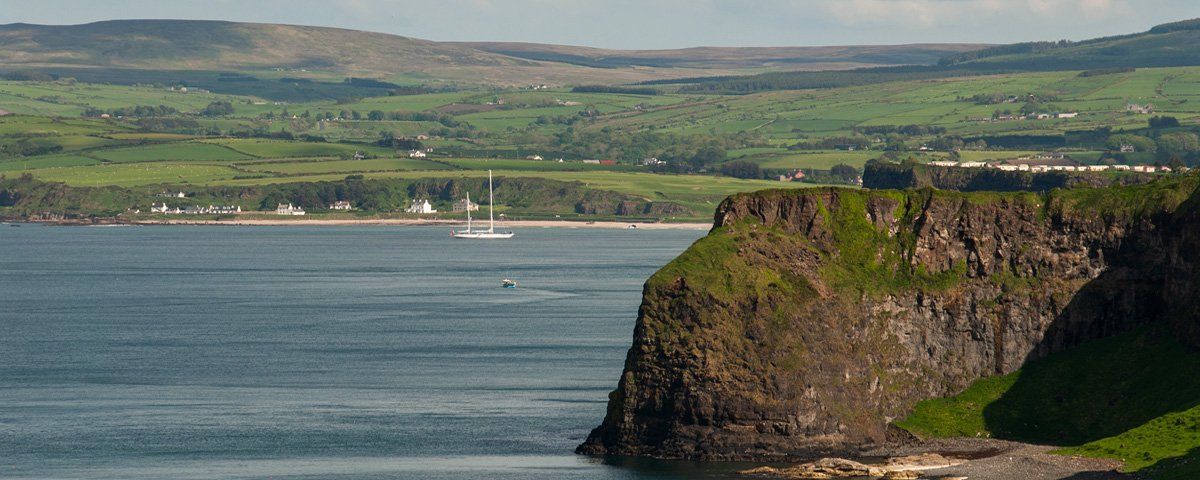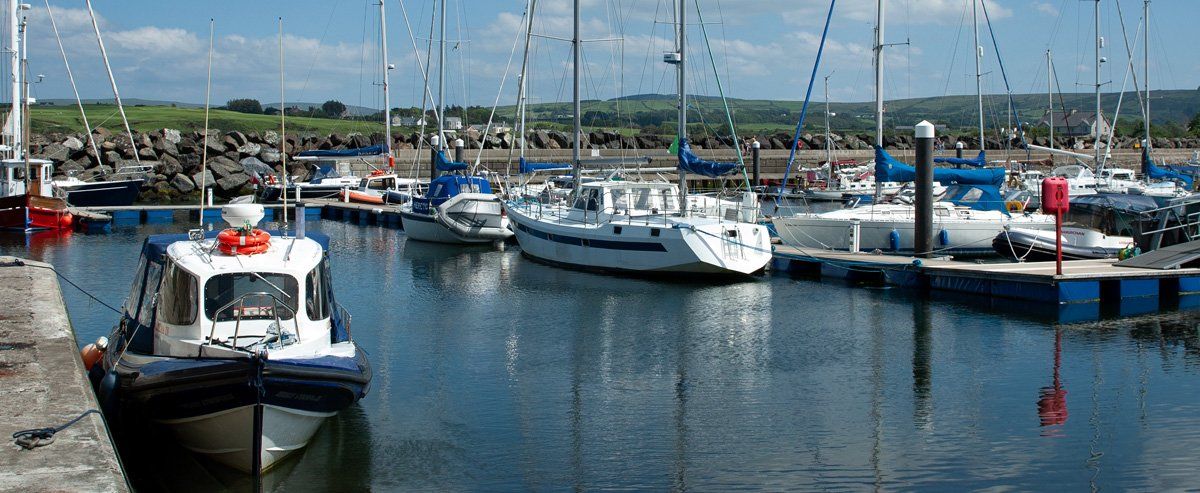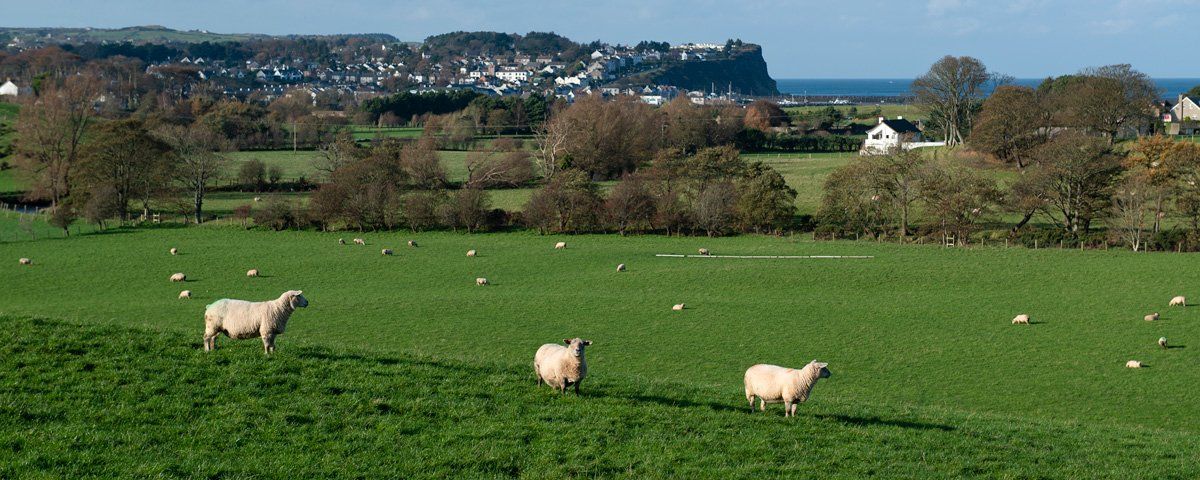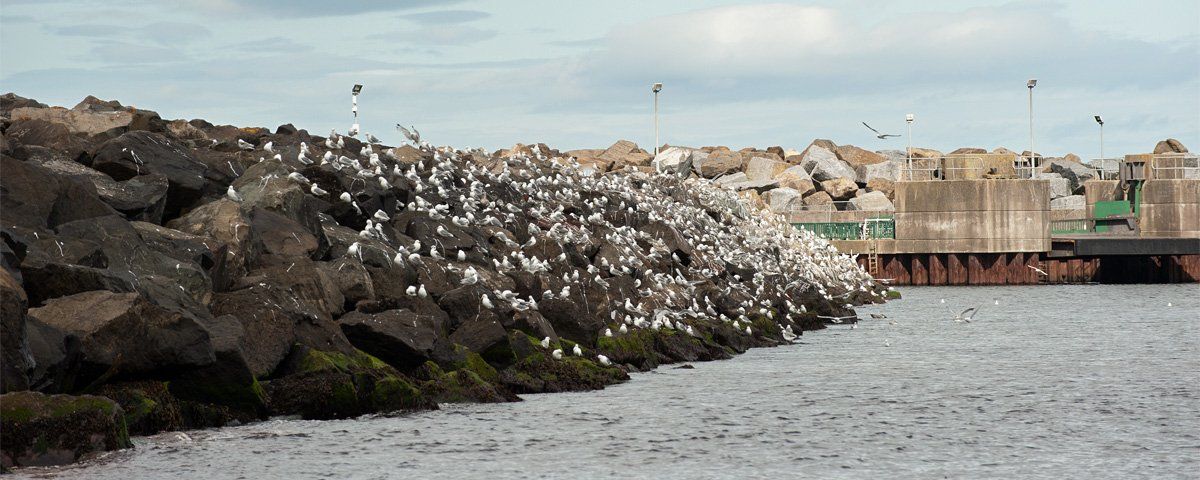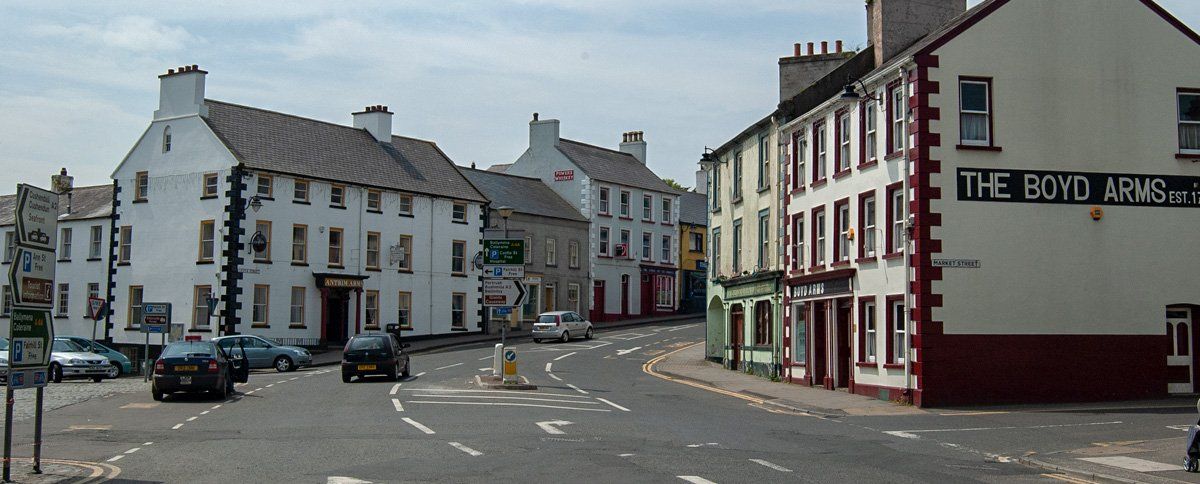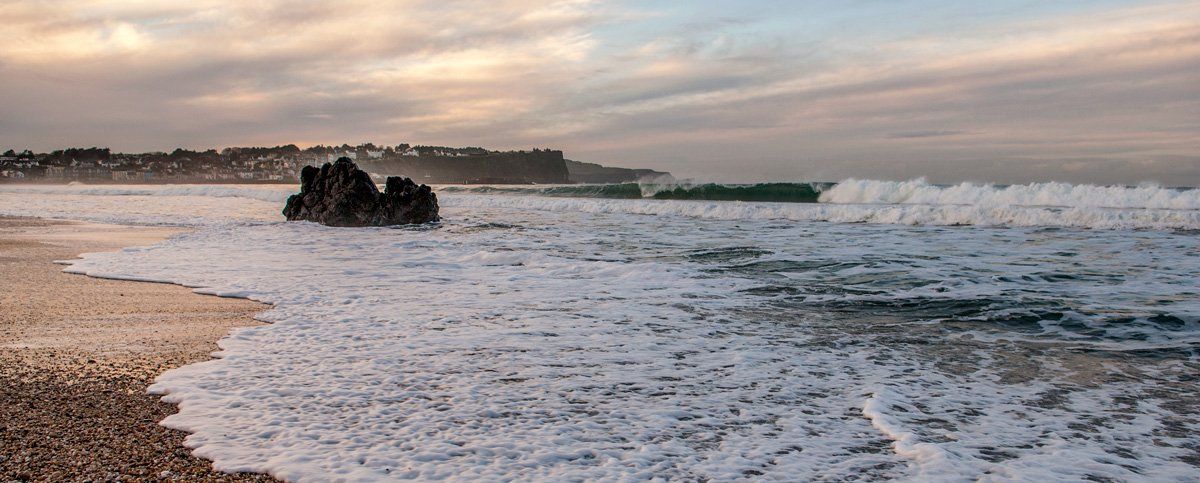Ballycastle may be regarded as a fairly typical Irish township which has grown up around two or three early settlements – Dunamallaght ‘the fort of the curse’, Dunrainey ‘the fort of the Queen’ and Duineeny ‘the fort of the fairs or games’. As for the locality in which Ballycastle is situated it is difficult to form an exact picture of it at the time of the Anglo-Norman invasion in the second half of the 12th Century. No particular map of Ireland is known of earlier date than 1489, and only a few are to be found between that date and 1572. We can make certain deductions in the matter of the probable origin and development of many of our Ulster towns. In the first half of the 12th century when diocesan episcopacy in Ireland began to replace the largely discredited monastic form we find reforming prelates like Malachy, Bishop of Conor arranging for the adequate support of the clergy by the introduction of the payment of tithe and the establishment of the parochial system.
The introduction of the parochial system in this country was later than in England with the inevitable result that the town or village, with its parish church, never became the focal unit of the parochial system as was the case in England.It is true, generally speaking, to say that when a parish in Ireland does not contain a town of the same name as the parish in which it is situated, that town must be of comparatively recent development. The best example in Co. Antrim of which I have in mind would be the large provincial town of Ballymena, which is in the parish of Kilconriola, there being no town of Kilconriola.In the Middle Ages the district now comprising the town of Ballycastle, formed part of the Anglo-Norman County of Coulrath (origin Coleraine) which included what is now North Antrim and that part of Co. Derry East of the Bann.
This Anglo-Norman settlement owed its origin to John de Courcy in 1177. The Normans farmed the land on the demesne system and it is interesting to note from the Ecclesiastical Taxation Rolls in connection with taxes levied to help to defray the cost of the Crusades, that the wealthy parts of the area included Loughguile, Portrush and Coleraine, but not Ballycastle.In mediaeval times the English language must have been but little spoken in this area. The Anglo-Norman settlers spoke French, while Irish remained the language of the natives but the Anglo-Norman hold over the area, particularly the remote corner of it in what is now Ballycastle must have been rather tenuous.
It declined about 1400 with the withdrawal of the lords and knights with the greater part of their retainers, to follow their feudal lords in the Hundred Years’ War in France. Families like Savage or De Mandeville of the Route or North Antrim, finding that they had been abandoned by the Crown and left to their own resources, adopted Irish manners and customs and acted as independent clans in every respect the same as if they were Irish clans. In a word they became more Irish than the Irish themselves. The eclipse of the Anglo-Norman power in north east Ulster together with disasters that on certain occasions overtook the Clandonnel South or MacDonnels in Cantire and the Western Isles of Scotland caused the tide of immigration to flow very fully towards the Antrim coast.
No less than seven such immigration periods may be noted between the 15th and 17th centuries. To these fairly persistent immigrations rather than to the Anglo-Norman power and influence must be attributed the development of Ballycastle at least from mediaeval times onwards. It was moreover, during the episcopate of Malachy as Bishop of Connor and subsequently of Down that stone and lime began in some instances, to replace wattle and daub in the erection of Churches in the North of Ireland. But the fact remains that until the beginning of the 17th century, when the history of modern Ulster may be said both officially and practically to begin, the province had few towns.
A substantial proportion of the population no doubt led purely pastoral lives. Has not Ulster, in the years preceding the Plantation, been described by the historian Du Pin as “the most constant in maintaining its liberty and in preserving Catholic Religion”, while at the same time that religion had disappeared from many other parts of the Kingdom. The continual wars of which Ulster had been the seat, prevented any settled form of communal like and must inevitably have been detrimental to the establishment of towns and villages. Yet by a curious irony of fate, the province which at the beginning of the 17th century appeared to be the most secure refuse of the old religion, was upon the eve of becoming what it has ever since remained – the most permanent seat of the reformed faith. But this is not all.
There is probably no part of the civilised world in which the science of town planning has played a more important part in shaping the physical environment of a people than has been the case in the Province of Ulster at the time of the Plantation. Of the characteristics of what is now the town of Ballycastle before the 17th Century little or nothing can be stated with any degree of certainty. Presumably, the earliest inhabitants were fisher folk who crossed from the Mull of Kintyre in Scotland, with Torr Head or Fair Head as their objective and, on being confronted with unscalable cliffs, they followed the direction of the prevailing east to west current, arriving eventually at Ballycastle Bay, where reasonably safe landing facilities and access inland were available.
The Margy River afforded them fresh water and the existence of abundant arable land in the vicinity established Ballycastle as a natural venue for settlement. The old name of the little boatslip is Port Brittas or British Port. It is also worth noting that parish on the extreme north eastern corner of Antrim (and the nearest part of the mainland of Ireland to Great Britain) is the parish of Culfeightrin, which means “The Corner of Strangers”. Dunamallaght and Dunrainey may be regarded as the first example of human habitation in the district. The third settlement, now represented by the ruins of Dunineeny Castle, may not be quite as old as the other two. Dunineeny stands on a promontory some 200 feet above sea level and overhangs the seashore. The fact that the word Dunineeny means “the fort of the fair or games” may be of some significance because it is highly probable that the well known annual Ballycastle Lammas Fair had its origin there.
One of the chiefs of the Clandonnell South, or Macdonnells of the Isles of Scotland – Sorley Boy Macdonnell – was traditionally born and died at Dunineeny. The castle was probably abandoned after his death in 1589. Later, another castle (which has now entirely disappeared) was built at one side of what is now the square or diamond of the town and around which the present town has largely grown up. There is now no evidence available of the habitation of the people of early times, apart from the sites or settlements I have mentioned.
The name Ballycastle originated from the castle erected at one side of what is now the focal centre of the town. This building was erected by the first Earl of Antrim, the youngest son of Sorley Boy, at the behest of James 1st, who gave him a grant of land extending from Larne to Coleraine, on which he was to erect 4 castles. One of these was the Castle of Ballycastle. It was unquestionably the nucleus of the present modern town. The castle was demolished well over one hundred years ago, as the ruin was in a dangerous state. The Fairs are those which fall on the last Tuesdays of May and November, (the hiring fair); the last Tuesday of July (Gooseberry Fair); the last Tuesday of October (Apple Fair) and the last Tuesday of August, the famous Lammas Fair, concerning which the well known song “the Oul’ Lammas Fair” was composed by the late Mr John H. McAuley.
Easter Tuesday is always a Fair Day in Ballycastle, whether Easter falls in March or April. The new fairs that is those established comparatively recently – are always held on the second Tuesday of the month. All the fairs are now much smaller than they used to be owing to so many government schemes for the sale of fat stock, pork and the like. In any study of Ballycastle five points should be borne in mind:- 1. Anterior to the Ulster Plantation in the early 17th Century the town – it could even be called such – must have been little more than a collection of thatched houses or perhaps mud cabins, with earthen floors. These cabins were almost certainly located at Dunineeny, Margietown, that is, the present quay or sea front and that part of the town now known as the Milltown. The fact that there is no parish of Ballycastle indicates that the town, as such, has no very great antiquity. It is situated in the parish of Ramoan.
2. Seventeenth century Ballycastle was largely, of not entirely the outcome of the settlement around the Castle erected about 1625 at the present Diamond. It is on record that after the rebellion of 1641 the town was practically deserted. The Hearth Money Rolls of 1669 return Ballycastle in the Parish of Ramoan and as containing 31 hearths, four of which were at the castle. In 1699 the tenements of the town occupied only an extent of three acres. In 1793 Parliament abolished the oppressive Hearth Tax and thus encouraged the peasant to build a comfortable cottage in place of his hovel. A house (which is still standing) was built on the site, the ruin being used as a quarry. In as much as the town grew up around the castle, it was natural to expect that the fairs would tend to move from Dunineeny to Ballycastle and, as fairs form an important element in the Irish economy, we must say a word about them in so far as they concern Ballycastle.
Most of the fairs here, as in England and elsewhere, are of ancient origin, though it is a curious fact that as yet little serious research – so far as I am aware – has been undertaken in regard to them. The fairs unquestionably play a most important part in the town’s economy. Ballycastle is not entirely a market town; it is not entirely a seaside resort. It is both and to that extent differs from Ballymoney on the one hand and Portrush on the other. Ballymoney is primarily a market town. Portrush is primarily a seaside resort. Ballycastle combines rather happily – both aspects or features. There are 17 or 18 fairs in the town annually and there is also a weekly market, Tuesday being the market day ever since the first market was established about 1612.
3. Eighteenth century Ballycastle might be described as “industrial Ballycastle” in as much as it was about the middle of this century that there was some economic development, including the construction of a pier and an outer and inner dock. Just before this industrial development, which unfortunately was not long sustained, the householders numbered sixty-two. As a consequence of the efforts of a native of the district (Colonel Hugh Boyd), whose energy and enterprise were greatly encouraged by liberal grants from the Irish Parliament, the village became a prosperous centre, having manufactories of salt and soap, a glass house, brewery and tan yards.
In 1734 Boyd obtained a lease in perpetuity from the 5th Earl of Antrim of the collieries near Ballycastle and two years later he obtained a deed of the village itself. Aided by the Irish Parliament to the extent of £23,000 he constructed an inner and outer dock – the former is now occupied by the tennis courts – to facilitate the export of coal for the supply of the city of Dublin. About this time Ballycastle had twenty vessels actively employed in trade, several thousands of tons of coal being annually exported. Colonel Boyd died in 1765, aged 75. He was buried in the vaults of Ballycastle Church, a pleasing building in the Graeco-Italian style, which he erected at his own expense. Soon after his death the importance of Ballycastle as a centre of industrial activity declined, almost as swiftly as it had begun.
4. Nineteenth century Ballycastle witnessed the steady development of the town principally as a seaside resort, the establishment of a ban in 1863, the construction of a narrow gauge railway to Ballymoney and the erection of a second pier from which limestone and sand were exported and coal and timber imported. This pier ceased to function about the beginning of the first world war and at present the town lacks suitable port or harbour facilities, either for the accommodation of fishing boats or small coasting vessels. In 1734 Boyd obtained a lease in perpetuity from the 5th Earl of Antrim of the collieries near Ballycastle and two years later he obtained a deed of the village itself.
Aided by the Irish Parliament to the extent of £23,000 he constructed an inner and outer dock – the former is now occupied by the tennis courts – to facilitate the export of coal for the supply of the city of Dublin. About this time Ballycastle had twenty vessels actively employed in trade, several thousands of tons of coal being annually exported. Colonel Boyd died in 1765, aged 75. He was buried in the vaults of Ballycastle Church, a pleasing building in the Graeco-Italian style, which he erected at his own expense. Soon after his death the importance of Ballycastle as a centre of industrial activity declined, almost as swiftly as it had begun.
5. Twentieth century Ballycastle might be described as a combination of two types of town – market and seaside resort. In this respect, I should say that it is rather lucky as the market aspect tends to give it an “all the year round” trade such as one does not find in seaside towns entirely dependent on the tourist traffic. tourist traffic. I do not suggest that the winter is not a slack time in Ballycastle, but the fact that the town has a weekly market is an undoubted commercial and economic advantage. Limeworks, forestry, saw mills, printing works, motor garages and the building construction trades provide employment for well over 100 persons but the local Council is anxious to encourage the setting up of a light industry to provide further employment.
Ballycastle is singularly fortunate to possess an almost endless variety of scenery and good recreational facilities. It is an excellent centre for some very pleasant excursions. The visitor may wander “o’er moor and fen o’er crag and torrent” and, given favourable weather, may enjoy a holiday in the most delightful of surroundings. Among the gifts of character transmuted from the early settlers to their descendants at the present day are the power to endure hardness, a gift for devising economics, independence, proper pride, sympathy, mutual helpfulness, discipline and piety, than which is in any country there are few qualities that contribute more to success and happiness.














